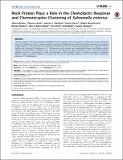| dc.contributor.author | Mayola, Albert | |
| dc.contributor.author | Irazoki, Oihane | |
| dc.contributor.author | Martinez, Ignacio A. | |
| dc.contributor.author | Petrov, Dmitri | |
| dc.contributor.author | Menolascina, Filippo | |
| dc.contributor.author | Stocker, Roman | |
| dc.contributor.author | Reyes-Darias, Jose A. | |
| dc.contributor.author | Krell, Tino | |
| dc.contributor.author | Barbe, Jordi | |
| dc.contributor.author | Campoy, Susana | |
| dc.date.accessioned | 2014-10-20T14:50:02Z | |
| dc.date.available | 2014-10-20T14:50:02Z | |
| dc.date.issued | 2014-08 | |
| dc.date.submitted | 2014-07 | |
| dc.identifier.issn | 1932-6203 | |
| dc.identifier.uri | http://hdl.handle.net/1721.1/90987 | |
| dc.description.abstract | The RecA protein is the main bacterial recombinase and the activator of the SOS system. In Escherichia coli and Salmonella enterica sv. Typhimurium, RecA is also essential for swarming, a flagellar-driven surface translocation mechanism widespread among bacteria. In this work, the direct interaction between RecA and the CheW coupling protein was confirmed, and the motility and chemotactic phenotype of a S. Typhimurium ΔrecA mutant was characterized through microfluidics, optical trapping, and quantitative capillary assays. The results demonstrate the tight association of RecA with the chemotaxis pathway and also its involvement in polar chemoreceptor cluster formation. RecA is therefore necessary for standard flagellar rotation switching, implying its essential role not only in swarming motility but also in the normal chemotactic response of S. Typhimurium. | en_US |
| dc.description.sponsorship | National Institutes of Health (U.S.) (Grant 1R01GM100473) | en_US |
| dc.language.iso | en_US | |
| dc.publisher | Public Library of Science | en_US |
| dc.relation.isversionof | http://dx.doi.org/10.1371/journal.pone.0105578 | en_US |
| dc.rights | Creative Commons Attribution | en_US |
| dc.rights.uri | http://creativecommons.org/licenses/by/4.0/ | en_US |
| dc.source | Public Library of Science | en_US |
| dc.title | RecA Protein Plays a Role in the Chemotactic Response and Chemoreceptor Clustering of Salmonella enterica | en_US |
| dc.type | Article | en_US |
| dc.identifier.citation | Mayola, Albert, Oihane Irazoki, Ignacio A. Martinez, Dmitri Petrov, Filippo Menolascina, Roman Stocker, Jose A. Reyes-Darias, Tino Krell, Jordi Barbe, and Susana Campoy. “RecA Protein Plays a Role in the Chemotactic Response and Chemoreceptor Clustering of Salmonella Enterica.” Edited by Axel Cloeckaert. PLoS ONE 9, no. 8 (August 22, 2014): e105578. | en_US |
| dc.contributor.department | Massachusetts Institute of Technology. Department of Civil and Environmental Engineering | en_US |
| dc.contributor.mitauthor | Menolascina, Filippo | en_US |
| dc.contributor.mitauthor | Stocker, Roman | en_US |
| dc.relation.journal | PLoS ONE | en_US |
| dc.eprint.version | Final published version | en_US |
| dc.type.uri | http://purl.org/eprint/type/JournalArticle | en_US |
| eprint.status | http://purl.org/eprint/status/PeerReviewed | en_US |
| dspace.orderedauthors | Mayola, Albert; Irazoki, Oihane; Martinez, Ignacio A.; Petrov, Dmitri; Menolascina, Filippo; Stocker, Roman; Reyes-Darias, Jose A.; Krell, Tino; Barbe, Jordi; Campoy, Susana | en_US |
| dc.identifier.orcid | https://orcid.org/0000-0002-4937-7912 | |
| dc.identifier.orcid | https://orcid.org/0000-0002-3199-0508 | |
| mit.license | PUBLISHER_CC | en_US |
| mit.metadata.status | Complete | |
